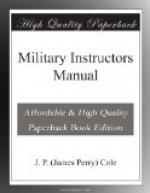COURSE: 1. SLOW FIRE.—10 yards. Minimum of one maximum of five scores. 2. QUICK FIRE.—10 yards. Minimum of one maximum of three scores. 3. AUTOMATIC FIRE.—10 yards. Minimum of one maximum of three scores. 4. TRENCH FIRE.—Minimum of one maximum of three scores.
Bayonet Training.
A. THE FUNCTIONS OF BAYONET TRAINING ARE:
1. To teach the correct use
of the bayonet until it becomes
instinctive.
2. To develop the fighting
spirit.
3. To develop speed, accuracy,
and cooerdination.
B. GENERAL PRINCIPLES:
1. Fencing, in modern combat,
is out of the question. Almost every
fight will consist
of but one or two motions. Hence the class
must be taught
that the best defence is the quickest offensive.
2. Every available means of
offence, with hands and feet as well as
with rifle and
bayonet, is a part of bayonet training.
3. Teamwork is essential.
Men must be taught, especially in the
combat, to exercise,
to seize every opportunity to act together.
4. Personal control during
combat, especially at night, will be
nearly impossible.
Control should be practiced, therefore, in
the form of clear
instructions delivered to the men before
assault, and fulfilled
individually.
5. In every assault and combat
exercise, the men must be taught
never to leave
an enemy alive, or who may be alive, behind them.
C. TECHNIQUE OF BAYONET COMBAT:
1. The point is the
main reliance. Its use should be practiced
in every possible
situation, until a correct choice or
combination of
long point, short point, and jab, and the
execution thereof,
becomes a matter of instinct.
2. The point must always be
directed at a definite target. The most
vulnerable points
of the body are: Lower abdomen, base of the
neck, small of
the back (on either side of the spine), chest,
and thighs.
Bony parts of the trunk must be avoided by accurate
aim.
3. The use of the rifle as
a club, swinging or striking, is
valuable only:
a. When the
point is not available.
b. In sudden
encounters at close quarters, when a sharp butt
swing
to the crotch may catch an opponent unguarded.
c. After
parrying a swinging butt blow, when a butt strike to
the
jaw is often the quickest possible riposte.
The use of butt
swings overhead or sidewise to the head or
neck, is to be
avoided; they are slow, inaccurate, easily
parried or side-stepped,
and leave the whole body unguarded.
After every butt
blow a thrust must immediately follow, since
no butt blow,
of itself, is apt to be fatal.
4. The parries must be regarded
and practiced chiefly as means of
opening the opponent’s




